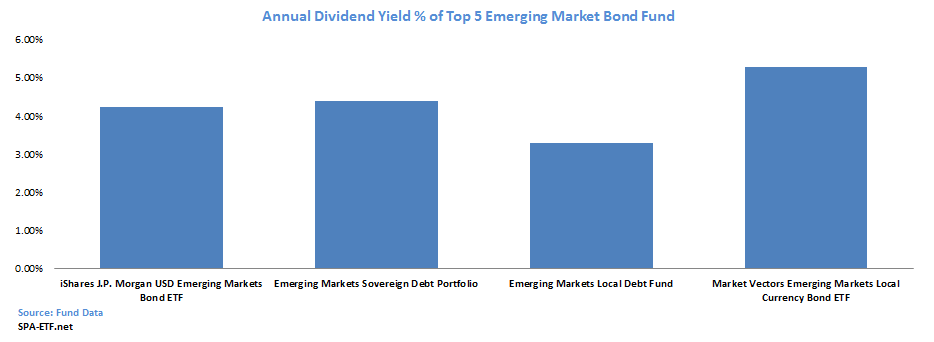The Better Bet Emerging Market Debt Or Equity (EEM EMB PCY ELD)
Post on: 16 Март, 2015 No Comment

Emerging markets have always known for their volatility. but it seems that they’ve whipsawed even more than normal lately. Broad-based developing market funds, such as the iShares MSCI Emerging Markets ETF (EEM ), have bounced around as shares have been pulled by good and bad economic and geopolitical news. They don’t call them emerging for nothing.
Yet, emerging markets can be a very important part of any portfolio given their growth prospects. And rather than deal with the volatility, there is another, more stable way to get your emerging markets exposure that can lead to pretty nice income as well.
A Big Bet On Bonds
Would-be emerging markets investors should consider skipping the equities markets and have a look at bonds. The emerging market bond sector continues to grow by leaps and bounds, as an increasing number of developing nations tap the credit markets. That’s producing plenty of opportunities for investors.
And while 99% of headlines on emerging markets focus on defaults, such as in Argentina, the truth is most emerging market debt is very much in the investment grade category. Strong balance sheets, fiscal responsibility, strong commodity resources and overall superior long-term prospects help make emerging market debt a prime destination. Overall, many emerging market nations and corporations have smaller debt-to-GDP or debt-to-equity ratios than their developed market counterparts. According to Bloomberg data, the 12 developing nations with the biggest foreign reserves (ex-China) hold a total of almost $3 trillion dollars.
Nonetheless, emerging market bonds still trade at higher yields and risk premiums than developed-market bonds. This is despite falling repayment and political risks. Investors are essentially getting junk bond -like 5% to 8% coupons with lower default risk. In time, this risk premium should diminish given their healthy prospects.
Meanwhile, bonds denominated in local-currencies could be just what the doctor ordered if the dollar once again resumes its decline. Over the past decade, currency appreciation accounted for nearly 17% of additional return on local currency emerging market debt. That’s a huge perk, as many analysts anticipate the dollar continuing its slide as inflation takes hold.
A Variety of EM Debt ETFs
Given that emerging market bonds offer more yield and less risk than developed market junk bonds, the time for investors to consider adding the sector could be now. A prime way to add the bond sub-sector could be the iShares JPMorgan USD Emerging Markets Bond ETF (EMB ).
With over $4 billion in assets, EMB is the largest ETF in the space and tracks 250 different dollar-denominated bonds. Emerging market nations first began issuing debt denominated in U.S. dollars as a hedge. Top issuing countries include Turkey, Russia and the Philippines. EMB currently yields 4.5% and charges just 0.60% in expenses. Running a more concentrated portfolio, which results in a higher yield, the PowerShares Emerging Sovereign Debt (PCY ) makes an ideal choice as well.

While the strong dollar has made EMB a big winner recently, adding a measure of local currency emerging mark debt still makes a whole lot of sense. Both the SPDR Barclays Emerging Markets Local Bond ETF (EBND ) and Market Vectors Emerging Markets Local Currency Bond (EMLC ) use an indexed approach, while the WisdomTree Emerging Markets Local Debt (ELD ) employs active management. That focus has allowed ELD to outperform its indexed rivals.
And just like corporations in the developed world, many emerging market firms have begun tapping the credit market to meet their funding needs. The iShares Emerging Markets Corporate Bond (CEMB ) tracks 192 different bonds from such issuers as Brazilian energy giant Petrobras (PBR ) and Mexican telecom Amé rica Mó vil (AMX ).
Given all the flavors of emerging market debt, investors may feel overwhelmed by all the choices. For those investors, the new Market Vectors Emerging Market Aggregate Bond ETF (EMAG ) might be the best choice. The ETF tracks all flavors of EM bonds – dollar denominated, local currency and high-yield – under one ticker. That could make EMAG, the ‘set it and forget-it’ option for retail investors. The blended portfolio yields 4.95% and carries just 0.49% in expenses.
The Bottom Line
Emerging market volatility will always be a reality, but there could be around the drastic ups and downs. Emerging market debt can offer junk-like yields at lower relative risk. With their growth and income potential, emerging market debt could be a great play for your portfolio.














